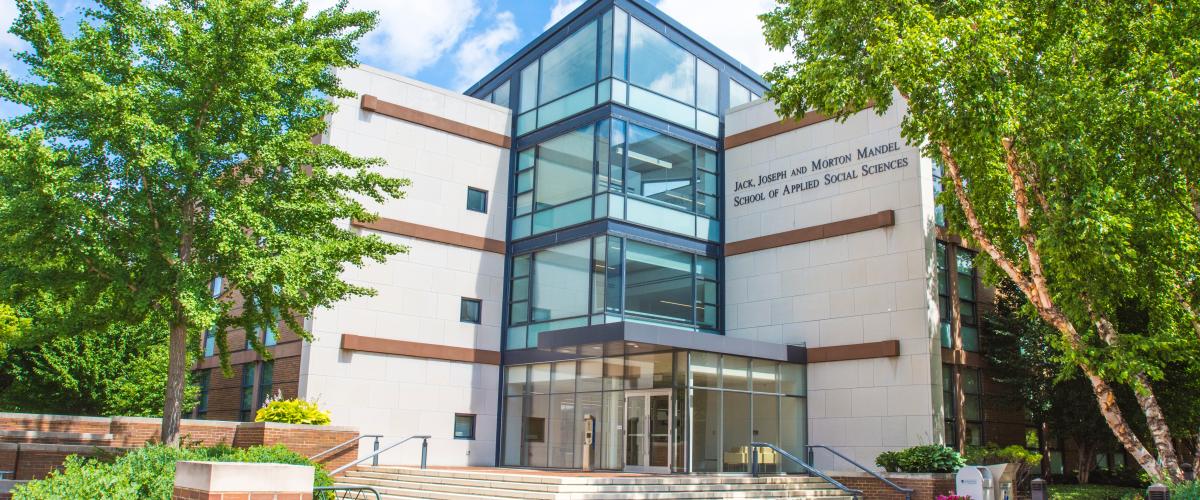November is Nonprofit Awareness Month, a time that celebrates and promotes the support of nonprofits in the United States. This month is especially relevant to Cleveland, which has a long and thriving history of nonprofit innovation—the city is the birthplace of the first community chest (a predecessor of the United Way) in 1913, created the first community foundation in the world (the Cleveland Foundation) in 1914, and is home to a world-renowned healthcare infrastructure.
It comes at no surprise then that Cleveland's economic prosperity and wealth during the early part of the 1900s also spawned an active philanthropic movement here, resulting in over 2,000 nonprofits in the Greater Cleveland area today. It’s also why the Jack, Joseph and Morton Mandel School of Applied Social Sciences began offering the Master of Nonprofit Organizations (MNO) program—it’s one of the first nonprofit leadership programs in the U.S. and one of just nine graduate programs to be fully-accredited by the Nonprofit Academic Centers Council.
Now more than ever, managing nonprofit organizations requires a commitment to doing good plus the skills to carry out an agenda of change.
In honor of Nonprofit Awareness Month, we’ll be spotlighting some of our MNO students and alumni.
Answers have been edited for clarity and length.
Sharie Renee (MNO ‘18)
- Alumna, Mandel School
- Founder/Executive Director of Cosmic Bobbins and Cleveland Sews. Working at the intersection of business and social good, Cosmic Bobbins provides screen printing, embroidery and sewing services. Cleveland Sews is a sewing education/workforce program that works in underserved communities, increasing stability and building hope in and with community members that have faced hardship due to racial and economic inequities.
1. What are you most proud of having accomplished at your nonprofit organization?
I am most proud of not having given up and continuing to see my vision through despite all the challenges we’ve faced. Most recently, I’m proud of this next phase we’ve entered. For the last couple of years we have been renovating an old building as our facility and revitalizing vacant land into an urban farm in the St. Clair-Superior neighborhood, which is right alongside where my family started their business 78 years ago. The building was in great disrepair, so it was a much bigger undertaking than I ever imagined, but it’s finally becoming a functional space and we are looking forward to fully activating it in the upcoming year. I’m excited to be able to launch more projects and welcome our program participants into the space.
2. What is the biggest challenge of working in the nonprofit sector?
For me as a founder, the reality is long hours, hardly any days off and no vacation. The biggest challenge I face, and I think many small nonprofits face, is being under-resourced. You have to be really lean and kind of scrappy in your approaches. When you are appropriately resourced, it’s much easier to do things well. We are working in a nonprofit space between arts/culture and workforce development—the issue with the workforce space for us is that the sewing industry lacks credentialing and clear career pathways. I contribute this to the offshoring of our industry—we tend to see little value in the trade. However, if you ask local professionals working in the local industry, most don’t feel this way at all. The trade of sewing has been life-giving to their personal pursuits. There needs to be a shift in perspective about the value the sewn trades provide for us on our own soil and the importance of local manufacturing production.
I think COVID started to put some of that into perspective with everyone hand-making masks, even though it was a huge disrupter organizationally for everyone. We were just starting to get our feet under us programmatically when it hit, so it has been like starting over in so many ways. The pandemic also taught us where the holes were in our work and structure, which has led us to new growth, but it can be a lot to shoulder when you are going through it all at once.
3. What led you to attend the Mandel School, and how has your CWRU experience prepared you to work in the nonprofit sector?
I came to graduate school with a problem to solve, which was wanting to create the academic scaffolding for Cleveland Sews. In wanting to take my community and educational work to the next level, I was encouraged to form a nonprofit organization. Because Cosmic Bobbins was already established as a business and funding our educational programs, we were misclassified as a 501(c)3 private non-operating foundation. At the time, I didn’t entirely understand what that meant but decided if I was dedicating myself to growing my vision and work, I needed to learn about the nonprofit sector.
I asked a dear friend and colleague of mine, Eric McGarvey, to chair our board and we ended up deciding we would go to graduate school together. I met Eric many years prior through Bonnie Richley’s Master of Science in Positive Organization Development & Change (MPOD) class at the Weatherhead School of Management, where Cosmic Bobbins and the Intergenerational School were serving as case studies for Business as an Agent of World Benefit. When we were deciding where to go to grad school, I told Eric the Mandel School was the only option because of our history and connection there.
I remember standing in admissions and they asked me what other schools I was applying to and I told them just Mandel. The look on their faces of utter confusion still makes me laugh to this day. For me, I felt an affinity with my work and Case Western Reserve, and the Mandel School seemed the perfect guide and mentor. During my time in the program, I was able to utilize Cleveland Sews to model the academics I was learning alongside Eric with the support of the institution, all of my professors and classmates. The Mandel School truly shaped and informed the foundation of Cleveland Sews, and for that I am eternally grateful.
4. What is your favorite memory of CWRU?
It’s hard to pick out one memory because there were so many wonderful ones—from Rob Fischer’s incredible support of me coming to the school and hosting a relationship-building event between MSSA and MNO students at our shop, to John Yankey’s “simulations” in class, to taking part in Mandel’s Centennial celebration and the “Healing Network Night” events with the Center on Trauma and Adversity. Even when I went through some personal tragedy, Dr. Fischer and the school were so supportive in helping me finish the program. Barbara Clemenson was a rock for me and I will never forget her kindness and empathy during such a difficult time in my life.
5. What advice do you have for others hoping to work in nonprofit organizations?
My advice is to remember why you started and follow your passion. For most founders I think we have a deep sense of conviction around our work and our life purpose. I know for myself, this experience has been about finding and manifesting my heart song. When you believe in the mission of your nonprofit or work, there is nothing more rewarding than having the opportunity to share your gift with the world—and that can sometimes lead other people to see the gifts they must share with society!
6. Knowing Cleveland is unusually supportive of the nonprofit sector, can you talk a bit about philanthropy in Cleveland?
Since we are a social enterprise and nonprofit program, we experience support a little differently than traditional nonprofit structures. In addition to self-funding through Cosmic Bobbins, Cleveland Sews is mostly funded as a fee-for-service model and through the support of individual donations and small community grants. Perhaps we are missing out on some larger opportunities, but I learned that philanthropy is poised to support established nonprofits.
In my experience, the reality of coming up in the nonprofit world as a start-up has been incredibly difficult. I think some people have great success with it, but I met a lot of hardship early on and I found that a lot of the politics of the sector were in conflict with the principles we align our work with in trauma-informed practice and community building. I realized that I could let those experiences create limitations to what I could accomplish or I could continue to forge my own path—to assess my skills and just keep doing the work in a meaningful way. I’m grateful to have found partners and individuals that authentically believe in our vision to help uplift the community, as it is important for me to work with organizations and people who have shared values, shared power and true alignment, knowing that we are shaping our community and the nonprofit sector for future generations. I know we will find more kindred spirits in this next growth opportunity of our work.
7. What are some meaningful ways someone can celebrate Nonprofit Awareness Month?
Volunteer your time or expertise to a nonprofit organization, monetarily support a nonprofit through direct donations, purchase goods or services that support an organization, or help with grant support. Since small nonprofits are commonly left out of the larger scope of philanthropy or don’t have fundraising resources, you can advocate for their work and inclusion in the sector.




